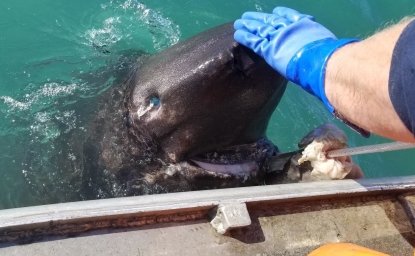With President Obama planning to speak at the U.S. State Department Conference on Global Leadership (GLACIER) in Anchorage, and Arctic foreign ministers and key non-Arctic representatives planning to attend, it appears that America’s top leadership is moving Arctic issues to a place of greater prominence in American foreign policy.
Hosted by the U.S. Arctic Executive Steering Committee, the White House seeks to strengthen coordination among Arctic nations on climate and related issues. This Arctic initiative, appropriately scheduled during the U.S. Chairmanship of the Arctic Council, underscores an Arctic debate that puts the U.S. at a crossroads in both its foreign and domestic policies. The Glacier meetings, through its public panels, also offer an opportunity for the Administration to more clearly identify national priorities, improve legislation, and encourage Congress to allocate the necessary financing despite lean and contentious times.
Shell Oil's Alaska operations illuminates challenges in the Arctic offshore. Plagued for three years by a series of mishaps while under intense international scrutiny, Shell has become a high stakes barometer to a petroleum industry that is closely watching its Arctic operations.
What is perhaps most disconcerting about the 39-inch gash that recently tore the hull of Shell’s 380-foot Finnish-owned icebreaker, Fennica, is that the site of the mishap -- Aleutian Island waters outside of Dutch Harbor -- were last charted in 1935, according to Rick Entenmann, Captain of the Alaska Marine Pilot Association. For the unmapped waters of the Bering Sea, Director of the Coast Survey Marine Chart Division Commander Shep Smith, called for better integration of new technology into U.S. seafloor mapping efforts.
Interests in the outer continental shelf
At the national level, Sen. Lisa Murkowski’s recently introduced bill would expand oil exploration of offshore Alaska, implement a coastal state revenue sharing program with the federal government and extend the life of existing oil leases. Given the environmental and social costs in coastal communities, the lead-time needed for industry to develop new technologies to protect health, safety and marine ecosystems, it is vital to extend the life of both existing leases and those forthcoming.
NGOs, some indigenous groups and scientists offer Shell's troubles, and other mishaps in Arctic waters, as proof that harsh Arctic conditions coupled with geopolitical and economic uncertainties prove we are not Arctic ready. Opposition to Arctic development appears to serve as a backdrop to the president’s recent expanded, and controversial, wilderness protections in Alaska’s Arctic National Wildlife Refuge, proposed limits on offshore leasing and new production in the National Petroleum Reserve, along with the recent Executive Order, "Enhancing Coordination of National Efforts in the Arctic." According to the U.S. Geological Survey, the Arctic National Wildlife Refuge's coastal plain alone contains an estimated 10.3 billion barrels of recoverable oil.
The 14 million Arctic residents, including indigenous peoples, have the most to gain -- or lose -- from Arctic development or environmental protections made by federal policy.
Sen. Murkowski has strongly criticized the administration, saying that the president had “declared war on Alaska’s future” for its restrictions on production that “lock up” and block development. She, along with Gov. Bill Walker and other state representatives, publicly expressed concern that the White House has produced policy that impacts Alaska, the state that makes the U.S. an Arctic nation, without consulting Alaska’s political representatives. The senator had previously chastised the federal government for being the only Arctic national government without a policy for the region.
Arctic foreign policy recalibrated
Arctic foreign policy, too, must be recalibrated. Climate change is likely to continue to produce conditions favorable to increased shipping traffic and lengthened navigational seasons. Just across the Bering, the Kremlin has made infrastructure development of the Northern Sea Route a priority, as much for nationalist reasons as for the commercial opening of a new “international transport artery.”
The United States must work outside of geopolitics and maintain cooperative relations with Russia in the Arctic. The Russian Federation, covering half of the Arctic and just across the Bering, demands coordination on disasters, spill response or illegal and unregulated fishing. In December, a South Korean fishing trawler sank in the frigid Bering Sea, 15 miles inside Russian waters. U.S., South Korean, and Russian coast guard aircraft and rescue ships coordinated efforts from extreme distances on a futile search for 52 missing crew members.
The Coast Guard’s proposed traffic lanes running from the Aleutian Islands through the Bering Strait offers a good next step start as part of a broader effort to increase governance, safety and security in the Bering Sea to handle likely increased traffic from Canada’s Northwest Passage and Russia’s Northern Sea Route.
Enhancing its commercial capabilities in northern waters, Russia plans to build 10 new navigational and emergency centers along its northern shores to strengthen its infrastructure and port facilities. The federation’s planned icebreakers will be critical not only for Russia’s ability to escort vessels across the Northern Sea Route but also to serve as a key element of Moscow’s strategy to supply and serve its northernmost settlements and, export natural resources and industrial trade. Without its ice-breakers, the Russian Federation would be less capable of exercising its sovereignty over its Arctic waters.
China’s pivot north and Russia’s pivot east
Non-Arctic nations also are accelerating their Arctic activity. China’s icebreaking research vessel, the Snow Dragon, has conducted six expeditions through the Arctic Ocean, with plans for a new ice breaker for polar expeditions. China’s “resource-diplomacy” strategy, promoting closer ties with Arctic states, aims to boost trade, commerce and scientific cooperation, evidenced by what The Diplomat called “China’s pivot north and Russia’s pivot east.”
Through the Arctic Council, or on its margins, the United States and the Russian Federation must find common ground and increase cooperation on scientific, maritime, search and rescue and unregulated fishing. The forthcoming table-top exercises among the Arctic Council membership and search and rescue planning between the U.S. and Russian Coast Guard offer a fine example of a proactive cooperative approach across the Bering. It would also illuminate gaps in infrastructure for future congressional funds to support a more robust Arctic policy.
The leadership role in the Arctic Council, vital in its own right, also provides the United States an opportunity to define its own Arctic national interests and develop appropriate policies more fully responsive to Alaskan thinking. The administration cannot wish away commercial activity under the guise of protecting the environment. The Anchorage–based GLACIER meetings offer a useful forum to build both Arctic-wide cooperation internationally, and to consider a domestic Arctic program that does not require Alaska to become the nation's’ environmental conscience.
What the US does best
Whether technological advances in commercial and public operations will enable safe, sustainable, and responsive to local will in the rugged, remote, and fragile region is a core question for Arctic development. What the U.S. does best is science, technology, engineering -- a “moon shot” approach could advance the capacity for Alaska to develop in a manner that can be job producing, environmentally sustainable and carbon conscious while protecting subsistence hunting and fishing.
If we do not actively define our interests in the Arctic, they will be defined for us by others. And Alaskans, and the nation, will suffer.
The opinions expressed here are solely those of the authors.
This article was originally published in Alaska Dispatch News.







